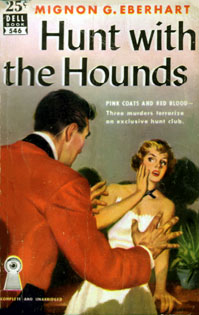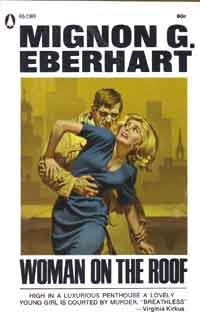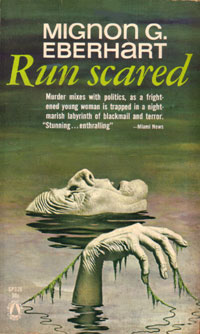At midnight Jenny Vleedam was awake and haunted by things she hadn't done and now would never have a chance to do, when the telephone rang. She knew that it was Peter calling her for he called at odd hours, anytime; she also knew that this, now, was the time to refuse to answer.
Call After Midnight (1964)
 Although these days she rarely turns up on Best Reads of the Year lists, Mignon Good Eberhart was once the third highest paid female mystery writer (right next to Agatha Christie and Mary Roberts Rinehart. In addition to more than sixty novels (including a number of historical mysteries), she wrote short stories, novellas, plays--even one screen play (the 1939 film The Murder of Dr. Harrigan). She was called “America's Agatha Christie,” but her real contribution is not to the classic mystery form but the direction and development of the Romantic Suspense sub-genre. Although these days she rarely turns up on Best Reads of the Year lists, Mignon Good Eberhart was once the third highest paid female mystery writer (right next to Agatha Christie and Mary Roberts Rinehart. In addition to more than sixty novels (including a number of historical mysteries), she wrote short stories, novellas, plays--even one screen play (the 1939 film The Murder of Dr. Harrigan). She was called “America's Agatha Christie,” but her real contribution is not to the classic mystery form but the direction and development of the Romantic Suspense sub-genre.
A terrified girl on a mysterious night flight-destination: murder…
A terrified beauty-a lonely road at midnight-murder and mystery…
For the pretty young guest, violent death waited amid the fog-shrouded trees of the Petrie estate...
A lovely heiress encircled by murder and terror...
She was rich, beautiful-and ripe for killing...
A lovely bride-a perfect wedding-a flawless setting for murder...
A beautiful woman on a murder ship-a spellbinding voyage into mystery and terror...
Get the idea? She may have been a Golden Age mystery writer, but Mignon G. Eberhart was no Agatha Christie.
This is not a criticism. As much as I love Christie -- and admire Rinehart (who Eberhart more closely resembled both stylistically and psychologically), I adore the nutty romantic elements of Eberhart. The beautiful (usually) girl, the glamorous often exotic setting, the troubled romance, the eerie atmosphere, the clothes, the old money, the creepy relatives, the convoluted motives. What's not to love?
 You have to be in the right mood to read Eberhart. Though plucky and well-bred, her heroines are some of the silliest in the mystery genre. The anonymous phone call bidding her hightail it down to the boathouse where murder has struck once before? She always answers on the first ring. Strange sounds in the attic of a house where murder walks the shadowy corridors? Sure, she's got five minutes to--er--kill; she'll just powder her nose and be right up. The smoking gun or bloody knife beside the still warm body? Never does the Eberhart heroine fail to pick it up and press her dainty little fingerprints all over it. Forget about the HIBK (Had I But Known) school, these chicks are at the top of the Why The Hell Would She class. They never have a decent alibi and they always have motive galore. You have to be in the right mood to read Eberhart. Though plucky and well-bred, her heroines are some of the silliest in the mystery genre. The anonymous phone call bidding her hightail it down to the boathouse where murder has struck once before? She always answers on the first ring. Strange sounds in the attic of a house where murder walks the shadowy corridors? Sure, she's got five minutes to--er--kill; she'll just powder her nose and be right up. The smoking gun or bloody knife beside the still warm body? Never does the Eberhart heroine fail to pick it up and press her dainty little fingerprints all over it. Forget about the HIBK (Had I But Known) school, these chicks are at the top of the Why The Hell Would She class. They never have a decent alibi and they always have motive galore.
So she heard the rustle and rasping of palmettos near her; she heard it and tried to escape the entangling harsh leaves, but not in time. A blinding crash neatly and instantly blotted everything out in pain and blackness.
Unidentified Woman (1943)
Did I mention the Eberhart heroine gets knocked out a lot? They give dear concussed Nancy Drew a run for permanent brain-damage. They also frequently faint.
So you're probably wondering what it is I so enjoy about these books? (Or, if you're one of the critics who finds my own Grace Hollister a little lacking in judgment, you probably think, Ah ha!). Well, for one thing, Eberhart is an excellent writer. I'm talking about her prose here. It's clean, it's effective, it's evocative.
The room was bare and hot and bright with electricity. Mina, in that incongruous ivory satin, sat down at her tall desk and drew a fat checkbook forward.
Katie stood quite still in her slim lace gown. She felt queer-the wine had been old and too fiery. It was nauseating. No, it wasn't that-it was something wrong in the room. Something wrong-
The writing is spare but almost lyrical.
 Another of Eberhart's strengths is characterization. This is an area where many of the Golden Age writers are flawed, creating ciphers to people their elaborate puzzles rather than believable characters. Eberhart's characters come complete with psychology-you may believe it is aberrant psychology, but they have genuine and believable motives for everything they do. After all, people in real life behave in exasperating ways too. Another of Eberhart's strengths is characterization. This is an area where many of the Golden Age writers are flawed, creating ciphers to people their elaborate puzzles rather than believable characters. Eberhart's characters come complete with psychology-you may believe it is aberrant psychology, but they have genuine and believable motives for everything they do. After all, people in real life behave in exasperating ways too.
Eberhart herself was a lovely and well-traveled woman who wrote more as an anti-dote to boredom and possible husbandly neglect than a need to earn her living. She had no children. In 1946 she divorced her husband of some twenty odd years to marry another man--who she divorced two years later to remarry Alanson Eberhart. Kind of sounds familiar, doesn't it?
I also admire her longevity: she wrote from 1929 thru 1988--and her productivity. She turned out a novel a year in addition to teaching and working on other projects--and her work is overall consistent in quality. Some of the plots may have been screwier than others, but the writing holds up, and her inventiveness in creating eerie settings and fraught atmosphere is unflagging.
Michael E. Grost of the A Guide to Classic Mystery and Detection site writes: “Suspense passages in Eberhart often show the heroine with a heightened sensory awareness of her surroundings, and are almost hallucinatory in their intensity.” Well, one man's hallucination is another woman's vivid imagination.
Eberhart is the classic escapist chick fic read. The books are always as much about the course of true love as the unraveling of a terrifying mystery. In the end, justice will triumph and love will find a way.
Yes, it was inevitable this return to Nice. But Richard and I can go now, anywhere we choose; we can return home when we like and there will be no whispers, no lingering doubts, no danger.We'll dance tonight and have champagne but pause for a moment when the New Year comes in and perhaps remember. Then the lights and the music will come up again.
THE NOVELS OF MIGNON EBERHART
The Patient in Room 18 (1929; Sarah Keate and Lance O’Leary)
The Mystery of Hunting’s End (1930; Sarah Keate and Lance O’Leary)
While the Patient Slept (1930; Sarah Keate and Lance O’Leary)
From This Dark Stairway (1931; Sarah Keate and Lance O’Leary)
Murder by an Aristocrat (1932; Sarah Keate and Lance O’Leary)
The Dark Garden (1933; also known as 'Death in the Fog")
The White Cockatoo (1933; also known as "Murder of My Patient")
The House on the Roof (1935)
Fair Warning (1936)
Danger in the Dark (1937; also known as "Danger in the Dark")
The Pattern (1937)
The Glass Slipper (1938)
Hasty Wedding (1938)
Brief Return (1939
The Chiffon Scarf (1939)
The Hangman’s Whip (1940)
Speak No Evil (1941)
Strangers in Flight (1941)
With This Ring (1941)
Wolf in Man’s Clothing (1942; Sarah Keate)
The Man Next Door (1943)
Unidentified Woman (1943)
Escape the Night (1944)
Wings of Fear (1945)
Five Passengers from Lisbon (1946)
The White Dress (1946)
Another Woman’s House (1947)
Pattern of Murder (1948; also known as The Pattern)
House of Storm (1949)
Hunt with the Hounds (1950)
Deadly Is the Diamond (1951)
Never Look Back (1951)
Dead Men’s Plans (1952)
The Unknown Quantity (1953)
Man Missing (1954; Sarah Keate)
Postmark Murder (1956)
Another Man’s Murder (1957)
Melora (1959; also known as "The Promise of Murder")
Jury of One (1960)
The Cup, the Blade or the Gun (1961; also known as "The Crime at Honotassa")
Enemy in the House (1962)
Run Scared (1963)
Call After Midnight (1964)
R.S.V.P. Murder (1965)
Witness at Large (1966)
Woman on the Roof (1967)
Message from Hong Kong 1969)
El Rancho Rio (1970)
The House by the Sea (1972)
Two Little Rich Girls (1972)
Murder in Waiting (1973)
Danger Money (1975)
Family Fortune (1976)
Nine O’Clock Tide (1978)
The Bayou Road (1979)
Casa Madrone (1980)
Family Affair (1981)
Next of Kin (1982)
The Patient in Cabin C (1983)
Alpine Condo Cross Fire (1984)
A Fighting Chance (1986)
SHORT STORIES
"Introducing Susan Dare" (April 1934, The Delineator; Susan Dare)
"Spider (May 1934, The Delineator; Susan Dare)
"Easter Devil (June 1934, The Delineator; Susan Dare)
"The Claret Stick (July 1934, The Delineator; Susan Dare)
"The Man Who Was Missing (August 1934, The Delineator; Susan Dare)
"The Calico Dog (September 1934, The Delineator; Susan Dare; also as “The Calico Dog;” Susan Dare)
"Bermuda Grapevine" (October 1938, The American Magazine)
"Express to Danger" (February 1939, The American Magazine)
"Deadly Is the Diamond" (June 1942, The American Magazine)
"Murder Goes to Market (July 1943, The American Magazine)
"The Crimson Paw (October 1952, The American Magazine)
"The Wagstaff Pearls" (1952, This Week; James Wickwire)
"Murder in Waltz Time" (May 1953, The American Magazine)
"Dangerous Widows" (1953; James Wickwire)
The Valentine Murder" (1954; James Wickwire)
"Mr. Wickwire’s 'Gun Moll' " (1956)
"The Blonde from Sumatra" (date unknown; James Wickwire)
"The Gate at Number Ninety" (date unknown)
The House by the Sea" (date unknown)
"The Jade Cup" (date unknown)
Murder by Night" (date unknown; James Wickwire)
The Old Man’s Diamond" (date unknown; Sarah Keate)
COLLECTIONS
The Cases of Susan Dare (1934; Susan Dare)
Five of My Best (1949)
The Crimson Paw (1959)
Best Mystery Stories (1988)
Three Days for Emeralds (n.) Random 1988 [New York City, NY]
PLAYS
320 College Avenue (1938; written with Fred Ballard)
Eight O’Clock Tuesday (1941; written with Robert Wallsten)
|

